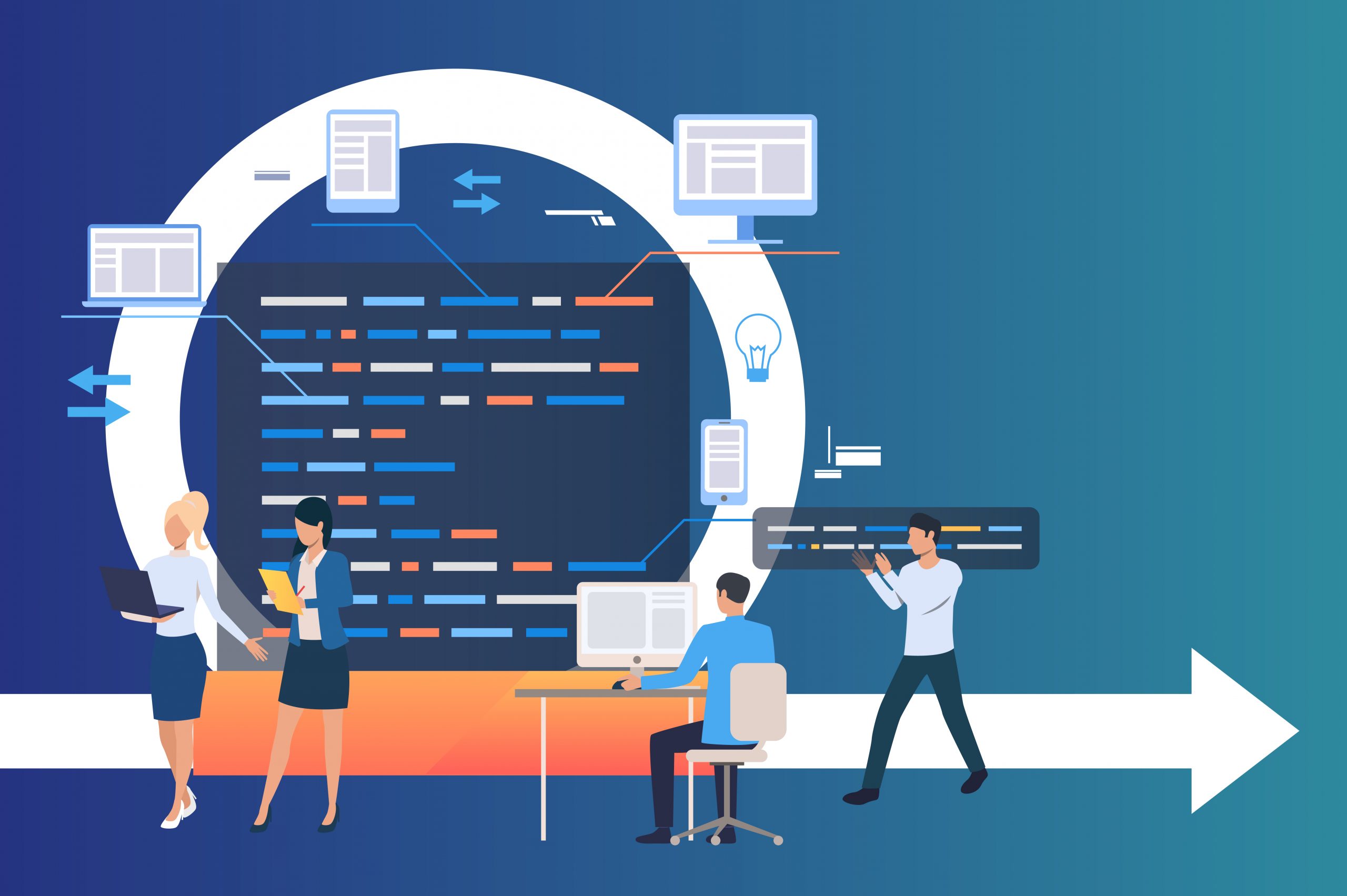09 Jun

|
Getting your Trinity Audio player ready...
|
SDLC is an acronym for Software Development Life Cycle, which is a framework used by software development organizations to build quality UI/UX designs and highly functional software. Throughout the years, SDLC has been used by companies to deal with the implications of software development and deliver end-products that meet the expectations of the clients. The process assists in the systematic delivery of the software with adequate planning, development, and testing rounds.
Even in SDLC, there are various phases and models that are important to understand if you want to use SDLC for your projects. In this blog, we will be covering these phases, the benefits of SDLC, and various models. You will also be informed on the common mistakes and challenges of SDLC along with brief advice on how to select the right software development model for your project or company.
Table of Contents
The Seven Phases of SDLC
The different SDLC phases are the different steps required to begin and complete the development of a software project. Although these phases are to be followed in a sequence, minor adjustments and modifications can be made depending on the model you select.
Phase 1: Planning and Requirement Analysis
This phase involves gathering inputs from the client, other stakeholders, and subject matter experts. Basically, the scope of work of the entire project is prepared and expected problems are listed out, such as the requirements for quality assurance analysis and other technical predicaments. Finally, a rough timeline is prepared and shared with the client.
Phase 2: Requirements Defining
In the second phase, a ‘Software Requirements Specifications (SRS)’ document is prepared to define precise requirements. This document includes every feature and functionality that the client wants to be written in full detail. After defining the requirements, the following feasibility analysis is done:
- Economic Analysis: Whether the requirements fit in the budget
- Timeline Analysis: Whether the requirements can be complete in the requested time frame
- Legal Analysis: Whether the requirements meet statutory and cyber law obligations
- Operational Analysis: Whether the team can actually develop the required features and functions
- Technical Analysis: Whether the company has adequate technical resources to develop the project
Phase 3: Architecture Designing
Based on the SRS document, different designs are planned for the software architecture, including High-Level designs (interface relationships and module outlines) and Low-Level designs (functional logics, database tables, error messages, etc.) All the designs are compiled into a DDS (Design Document Specification) doc, which is then shared with all important stakeholders for review.
Phase 4: Software Development
Once the designs are finalized, the actual software development starts in the fourth phase. It includes the programming of the source code and is done without haste in a strategic manner. The designs are broken down into different units and tasks and allocated amongst team members who then use programming principles to give shape to the project. After interpreting, compiling, and debugging the source code, the project moves into the next phase.
Phase 5: Testing
The testing phase involves the deployment of the software in a testing environment to validate the functionality of the entire software. Any defects in the software are mapped, resolved, and tested till the functionality is proved. The quality of the software is also measured by comparing it with the standards defined by the stakeholders in the SRS document.
Phase 6: Deployment
A beta version of the software is released for a limited segment of the market who then use the software and provide feedback. After feedback collection, any necessary changes are made and the final software is released.
Phase 7: Maintenance
Regular maintenance of the software takes place over time. The maintenance issues involve fixing any bugs that went undetected in the testing phase, software enhancements to add more functionality, and timely updates to ensure quality to the software.
Benefits of SDLC
The software development life cycle process provides a means to evaluate software requirements, schedule, and begin with the development process more strategically. If adapted properly, it can provide companies with the following benefits:
1. Organizes Efforts
Collaborating team efforts and keeping everyone on the same page is important in large-scale software development projects. SDLC phases act as a structural plan to divide the team into various roles and responsibilities. The SDLC process also guides the team members throughout the various development phases and leads to the gradual completion and deployment of the software.
2. Reduces Development Costs
Adherence to SDLC brings economic benefits to software development companies. SDLC includes the calculation of technical requirements, operational costs, and overhead costs beforehand to minimize expenditure. It makes the development team more productive so that they can work at their optimum levels and eliminate waste efforts. The predefining of functional logic and systematic testing rounds also ensure high-quality software, which reduces post-deployment bugs and maintenance.
3. Faster Development
SDLC enables software developers to complete the project in the desired timeline. Some SDLC models even provide flexibility for changes in the timeline by prioritizing some sets of features over others and releasing partial software mid-development. For example, Scrum is one such model that allows for quick launch of the software by focusing on all essential features and the development of a Minimal Viable Product (MVP) software.
4. Better Chances of Success
SDLC assists companies in managing their overall workload and working on multiple software development projects. Not only does it have a proven track record of providing success to hundreds of software development businesses, but it has also become a standard required to match the productivity levels of large-scale IT organizations. In addition, projects completed with SDLC are recorded to provide higher satisfaction rates to customers.
Different Models of SDLC
The software development life cycle process can be followed by adopting various development models. These models are based on the principles of SDLC and can be used to resolve the various complexities of a project.
1. Waterfall Model
The waterfall model adheres to the exact principles of the software development life cycle and completes the project in a sequential process. Every phase in the Waterfall model is dependent on the outcome of the previous phase, which makes it impossible to introduce any new feature requirements mid-development. Any changes would require the development team to begin the entire development from scratch.
Advantages of Waterfall Model:
- Easy to follow
- Has specific deliverables and timeframe
- Has predictable outcomes
Disadvantages of Waterfall Model:
- Does not allow for any changes in mid-development
- The time-consuming software release can frustrate the clients
2. V-Model
The V-Model is derived from the waterfall model. In this model, every stage of the waterfall model is complemented with a round of testing. It is simple to follow and results in the development of a highly satisfying end-product. Due to the presence of parallel testing rounds, the V-model is also known as the ‘Validation and Verification” model. Despite the presence of these testing rounds, the model does not get complex and is easy to control.
Advantages of V-Model:
- Results in the development of a highly satisfactory product
- Easy to follow
- Begins with thorough planning
Disadvantages of V-Model
- Does not allow for mid-development changes
- Not suitable for large-scale projects
- Only suitable when the client’s requirements are strictly pre-defined
3. Scrum Model
The Scrum software development model follows agile methodology, which allows for mid-development changes. In this SDLC model, the development is split into various sprints. Each sprint follows the SDLC phases and the first sprint focuses on developing a base, whereas others work on specific sets of features called backlogs. Scrum model sprints aren’t time-consuming and are based on shared roles and responsibilities.
Advantages of Scrum Model
- Allows for iterative development
- Mid-development changes are possible
- Releases a market-ready software
Disadvantages of Scrum Model
- No specific timeframe
- Lengthy development
4. Kanban Model
The Kanban model uses a Kanban board where each task is mentioned along with its priority. Developers with available bandwidths select their tasks (known as the pulling technique) or they can also work on a single feature collectively. The Kanban Model completes the project feature by feature and allows for changing priorities. It also calls for better coordination amongst the development team.
Advantages of the Kanban model:
- Allows for mid-development changes
- Prioritizes the development of more important features
- Faster development
Disadvantages of the Kanban model:
- Individual performance affects the whole team
- Not as well planned as other models
5. Agile Model
The agile model divides software development into various releases. Each release is shown to the client to ensure if he is satisfied with the direction for the software. This way, the agile model ensures maximum satisfaction to the client. The principle of incremental progress is followed in the agile model.
Advantages of Agile Model:
- High client satisfaction rates
- Follows incremental progress
- Allows for mid-development changes
Disadvantages of Agile Model:
- Difficult to estimate delivery timeline and resources
- Not suitable for small size startups
6. Spiral Model
The spiral model is based on the principles of both Agile and Waterfall methodologies. It keeps iterating on four rounds, which are:
- Determining objectives
- Identifying risks
- Developing and testing
- Planning the next iteration
The spiral model heavily focuses on risk analysis to bring quality to the end product. It also includes the collection of user feedback and the development of various prototypes.
Advantages of Spiral Model
- Focuses on risk analysis
- Allows for changes even at the later stages of development
- The first prototype is released very early for collecting user feedback
Disadvantages of Spiral Model
- Expensive
- Inappropriate for small projects
7. RAD Model
The Rapid Application Development (RAD) model involves the development of software with prototyping and subsequent iterations. In this model, the software requirements are collected from a focus group of customers instead of the client. It does not adhere to any specific plan, which in turn results in aggressive development and highly functional prototypes. The RAD model also depends on the reusability of important elements.
Advantages of the RAD Model:
- Faster development
- Allows for changes mid-development
- Requires less number of iterations
Disadvantages of the RAD Model:
- Follows no specific plan
- Suitable for small projects only
- Difficult to manage
8. The Big Bang Model
The Big Bang software development life cycle model does not follow any specific set of guidelines. It is totally random and relies on the maximum utilization of resources. To begin the development with this model, software companies do not need pre-defined requirements and can release the end-product in any number of stages.
Advantages of the Big Bang Model:
- Requires no planning
- Focuses on the maximum utilization of resources
- Does not follow a strict schedule, giving more flexibility to developers
Disadvantages of the Big Bang Model:
- Only suitable for smalls size projects
- Does not ensure quality
- Not suitable for long-term projects
Common Problems that Companies face with SDLC
Software development companies often encounter the following problems while working with SDLC Models:
- Unclear Requirements: The end-product relies heavily on the software requirements and the selected set of features. When these requirements aren’t properly defined, it is difficult for a company to develop functional software and ensure quality.
- Agility: Not all SDLC requirements are based on the agile methodology. As a result, any changes in the requirements slow down the development process and deteriorate the quality. To resolve this problem, companies prefer using agile models like Scrum and Kanban.
- Poor Scheduling: Models following agile methodology often face the problem of poor time scheduling. This is due to frequent changes in the requirements, which make it difficult to provide a timeline for project completion.
- Model Identification: Identifying the correct SDLC model for a project requires a thorough analysis of the project. Using the wrong model can lead to various customer satisfaction, project quality, and low revenue problems.
How to Select the Correct SDLC Model for a Project
Although there’s no specific guide to select the correct SDLC model for your project, you can refer to the following table:
| Type of Project | Recommended SDLC Model |
| Has unclear requirements | Agile, Scrum, Kanban and RAD |
| Requires Unfamiliar Technology | Agile and Scrum |
| Large Size Complex Projects | Agile, Scrum, Kanban, and Spiral |
| Small Size Projects with No Complexity | Waterfall, RAD, and Big Bang |
| Small to Medium Size Projects with Low Complexity | Waterfall, Rad and V Model |
| Has Short Turnaround Time | Rad, Waterfall, and Big Bang |
| Has Client Involvement and Visible Schedule | Agile, Kanban, and Scrum |
The aforementioned table is only for reference. A thorough analysis of your project including the complexity of features, required technology, delivery timeframe, and client’s objectives will help you determine the actual model.
Summing Up
Software development companies, especially startups, can benefit a lot following the SDLC process. It can help them streamline various work processes and negate problems like ineffective management, overhead costs, and poor client satisfaction. As companies follow the SDLC process, they will gain proficiency in selecting the correct model and delivering a quality end-product within the said time frame. All this is essential for a software development company to succeed.
Another option for small-size companies to utilize their models for maximum advantage is to outsource their work to an experienced organization. FATbit Technologies is a leading software development company that assists entrepreneurs in launching eCommerce businesses with its readymade solutions and agile development services. For long-term projects with diverse features and need for agility, share your requirements with FATbit Technologies and they will help you deliver quality software with the right development approach.



1 Comment